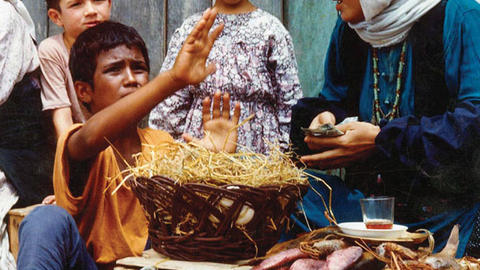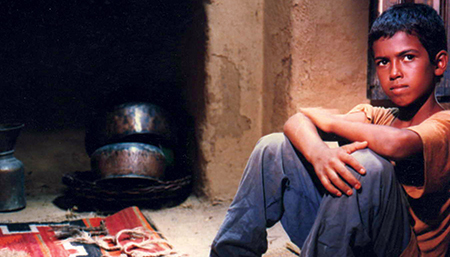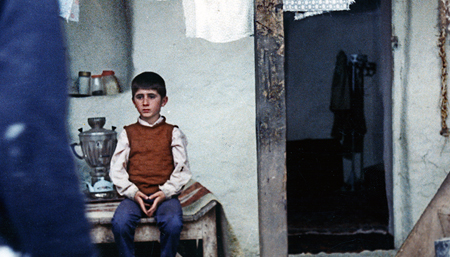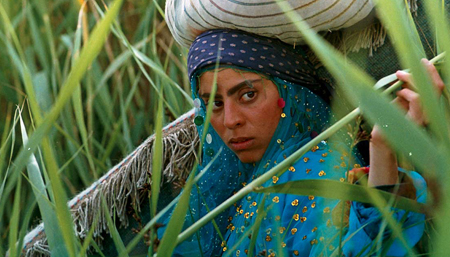
A society from the ashes: celebrating Masters of Iranian Cinema
Posted on Mon 8 June 2015
Nariman Massoumi, Senior Lecturer in Film & Television Studies at Bath Spa University, writes about the political and cultural context to films in our upcoming Masters of Iranian Cinema season.
As part of our ongoing Conversations About Cinema: Impact of Conflict season from Fri 12 – Mon 15 June we are hosting Masters of Iranian Cinema, a short season celebrating the most magical and moving Iranian films of the last thirty years.
We asked Nariman Massoumi, Senior Lecturer in Film & Television Studies at Bath Spa University, to provide a bit of political and cultural context to the films in the season. Below he explains more about Iran's rich cultural traditions and the complex political situation at the times these films were made. Thanks to Nariman for sharing such great insights.
Masters of Iranian Cinema is a long overdue but welcome mini-season showcasing three acclaimed Iranian films that are rarely, if ever, available on the big screen. While pointing a lens on Iranian culture and society during a period of flux, the films also address much larger, universal themes about perseverance against adversity, the struggle for solidarity and the barriers that limit human potential.

Bashu, the Little Stranger (Fri 12 June at 15:00) is a warm and effecting film about a young boy who flees his village in the Southern province of Khuzestan after a bombing raid leaves him orphaned and homeless. Finding refuge with Na’i, a single woman in a village in the northern province of Gilan where they speak the local dialect of Gilaki, Bashu and Na’i struggle to overcome ethnic and language barriers to seek a common bond, their personal connection forged through the haunting presence of absent family members.
The politics of this should not be underestimated. Made in the midst of the 1980-1988 war with neighbouring Iraq (an Arab country) and the nationalist fervour against the 'common enemy', the film's focus on the impact of war and a plural Iranian ethnic identity renders it profoundly anti-racist and anti-war.
At the time, these themes deeply resonated with those of us who had fled the Iran-Iraq war and settled elsewhere, relating Bashu's story with our own painful memories of displacement, experience of racism and overcoming language barriers when seeking asylum in a foreign country.
This was confounded by the hostile depictions of Iranians that were prevalent on Western screens throughout the period and ever since the Iranian Revolution of 1979 toppled the pro-Western Shah, establishing the Islamic Republic. Hollywood's output was deplorable in this regard - most notably in Not Without My Daughter (1988) - which warned explicitly against any intercultural relationships with Iranian immigrants, depicting them as irrational, patriarchal, angry and violent.
Entering this arena, the post-revolutionary Iranian films of the 80s and 90s offered a much-needed respite with nuanced, sympathetic and humanist portrayals of Iranian people that celebrated the country's idyllic rural landscape and foregrounded our rich and poetic, cultural traditions. A cinema of modesty and compassion, it provided a means through which to renegotiate our relationship to our culture and to counter harmful misconceptions.

Some of the hallmarks of these films drew comparisons with Italian post-war neorealist cinema such as the real location filming, long takes or use of non-professional actors. One key feature was the abundance of child-centred stories focused on simple but allegorical struggles. Abbas Kiarostami was a figurehead in such narratives, having directed children prolifically since his first short film Bread and Alley (1970) about a boy trying to get himself and his bread past a hungry dog. Where is My Friend's House? (Sat 13 June at 15:00) is exemplary of this style.
Ostensibly about a young boy Ahmad’s desperate attempts to halt a friend’s impending punishment by returning his homework book before the next class, the film turns the search for his friend's home into an arduous journey of self-discovery. His repeated failures to locate the house expose his frustrations and vulnerability in a myopic adult world that doesn't listen to him. Through the sublime labyrinth of Iranian village streets, the resolute journey elucidates and champions Ahmad’s idealist spirit, dogged determination and uncompromising friendship, where the real destination to be reached lies within the exhaustive pursuit itself.
Such metaphysical concerns are indebted to Iranian poetic traditions (the title comes from a poem by Sohrab Sepehri), and evoked most evidently in the recurring image of Ahmad running up a zig-zag path leading to a tree at the top of a hill. This iconic motif is where Kiarostami departs from the conventions of neorealism (with which he is often associated), having not only had the tree planted and the path constructed specifically for the film, but also the village houses and streets, where Ahmad’s exasperated meanderings take place, painted and swept.

The inspiration for the aesthetics of Mohsen Makhmakbaf's Gabbeh (Mon 15 June at 18:00) comes from its own subject matter. A gabbeh is a type of Persian carpet, made by nomadic communities such as the Qashquai, which has a course quality (‘gabbeh’ literally translating to 'rough'), where weavers incorporate their own personal stories and individual style into the rug. The film turns one carpet's depicted image of a young woman (also named Gabbeh) into a lyrical fable about denied love, ritual and desire.
Ethnography meets expressionism, as luscious green fields, vivid blue skies and scarlet-red poppies saturate the screen, replicating the vibrancy of the hand-made rugs. So too does the story structure, knitting together present and past, reality and fantasy, where the art of weaving is synonymous with the cinematic stitching together of the gracefully photographed natural world.
Gabbeh's politics is said to lie in its contrast with the monochromatic uniformity of veiled women and revolutionary idolatry of the Islamic republic. Indeed, a common explanation for the tropes of Iranian cinema presented in this season was how they reflected filmmakers’ creative attempts to sidestep government censorship regulations by embedding social critique implicitly and allegorically.
Less often cited, however, is how the austere aesthetics of the films, focusing on the plight of the poor and dispossessed, echoed the revolutionary ideas and murals championing the mostazafin (oppressed) as well as Shia Islam’s notions of piety and sacrifice. Neither is there much mention about the influences of ta'zieh performance, a traditional religious avant-garde theatre (particularly apparent in Bashu), on film form. Or, for that matter, how government restrictions on foreign film imports and state funding for albeit censored films, paradoxically made those films possible.
In reality, post-revolutionary Iranian cinema's uniqueness was defined by its context: a society emerging out of the ashes of a popular and contested revolution and the devastating consequences of a foreign invasion. It is these contradictions that lie at the heart of the films in Masters of Iranian Cinema - and it leaves few of us unscathed.
Masters of Iranian Cinema is presented in partnership with WOW Wales One World Film Festival as part of the British Council Iran's UK-Iran Season of Culture. Part of our ongoing Conversations About Cinema: Impact of Conflict Season.
